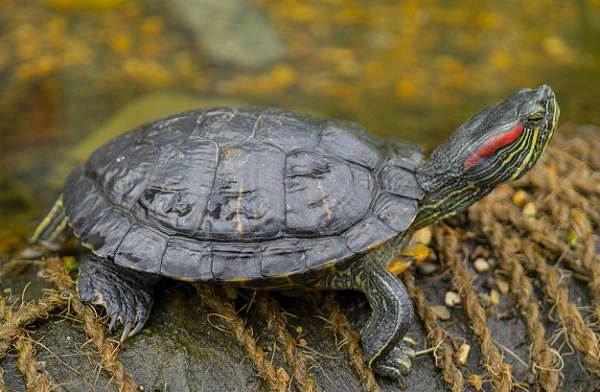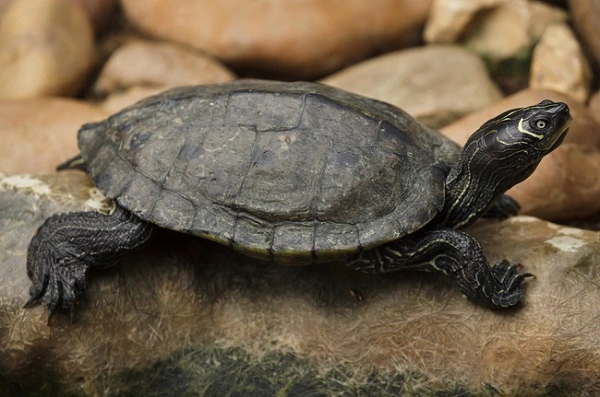It is not often that you come across a river turtle. In fact, many people may never see one in the wild. These shy creatures are rarely seen, which makes spotting one all the more special. If you’re lucky enough to see a river turtle in the wild, take some time to appreciate this graceful creature. Their long necks and smooth shells make them a beautiful sight to behold. Keep an eye out for river turtles when you’re next near a river or stream; they’re definitely worth taking the time to observe!

River Turtle Description
River turtles are a type of freshwater turtle that can be found in rivers, lakes, and other freshwater habitats. River turtles are typically smaller than other types of turtles, and they have streamlined shell that helps them swim quickly through the water. River turtles are omnivorous, and they eat a variety of aquatic plants and animals. River turtles are also known for their long lifespan; some species of river turtle can live for over 100 years! River turtles are popular pets, and they make great companions for both children and adults. If you’re interested in owning a river turtle, be sure to do your research first; like all pets, river turtles require proper care and attention. River turtles are amazing creatures, and they can bring joy to any home.
River Turtle Habitat
River turtles are a threatened species found in the rivers of Central and South America. River turtles are under threat from habitat loss, pollution and predation. River turtles need clean water to survive and thrive. River turtles also need access to sunny basking spots and places to hide from predators. River turtles lay their eggs on land, so they need access to both river and land habitats. River turtles are an important part of the ecosystem and play a role in controlling the populations of fish, insects and other animals. River turtles are also a food source for many animals, including humans. River turtles are a vital part of the ecosystem and need our help to survive.
River Turtle Diet
River turtles are a type of turtle that is found in rivers all around the world. These turtles have a diet that consists mostly of fish, but they also eat other things like plants and insects. River turtles are able to find food by using their sense of smell. They will often eat dead fish that they find in the river. River turtles are also known to eat other animals like crayfish, frogs, and snakes. River turtles are not picky eaters and will eat just about anything they can find in the river.

River Turtle Size
River turtles are a type of aquatic turtle that gets their name from the fact that it spends the majority of their time in freshwater environments such as rivers, streams, and lakes. River turtles are generally quite small, with most species reaching an average size of around 6-8 inches in length. The largest river turtle species is the alligator snapping turtle, which can grow to be up to 2 feet long. River turtles are typically omnivorous, meaning that they will eat both plants and animals. This diet can vary depending on the specific species of river turtle, but common food items include insects, fish, frogs, and aquatic plants. River turtles are found throughout the world in a variety of different habitats. In the United States, river turtles can be found in states such as Florida, Louisiana, and Mississippi. River turtles play an important role in their ecosystems by helping to control the populations of other animals such as insects and fish. River turtles are also popular as pets due to their docile nature and relatively small size.
River Turtle Lifespan
River turtles are a species of turtle that is native to North America. They are typically found in rivers and streams, and can live for up to 30 years in the wild. River turtles are omnivorous, and their diet includes both plant and animal matter. River turtles are also known to be one of the longest-lived species of turtle, with some individuals living for over 50 years. River turtles are popular pets, and many people enjoy keeping them as houseplants. However, it is important to note that river turtles require a large amount of space and should not be kept in small tanks or aquariums. River turtles are also susceptible to diseases and parasites, so it is important to consult a veterinarian before purchasing one.
River Turtle Behavior
River turtles are a type of turtle that is found in freshwater habitats. River turtles are generally smaller than other types of turtles, and they have a more streamlined shells. River turtles are good swimmers and often bask in the sun on logs or rocks. River turtles are omnivorous, eating both plants and animals. River turtles usually lay their eggs on land, near the water’s edge. The female river turtle excavates a nest in the sand and deposits her eggs. She then covers the nest with sand and leaves. River turtle eggs take about two months to hatch. River turtles can live for up to 30 years in the wild.
River Turtle Speed
River turtles are a type of turtle that is found in freshwater habitats. They are one of the fastest turtles on land, able to reach speeds of up to 8 miles per hour. River turtles are highly proficient swimmers as well, able to reach speeds of up to 4 miles per hour in water. This combination of speed and swimming ability makes them one of the most successful turtles in terms of predator avoidance and escape. River turtles are also able to tolerate a wide range of environmental conditions, making them one of the most adaptable turtle species. As a result, river turtles are found in a variety of habitats across the world, from North America to Africa.
River Turtle Hunting
River turtles are a popular delicacy in many parts of the world, and their meat is said to be delicious. However, River turtle hunting is often controversial, as it can lead to the decline of River turtle populations. River turtles are hunted for their meat, shells, and eggs, and all three are considered to be valuable commodities. In some areas, River turtles are so prized that they are only caught during specific seasons. River turtle hunting typically occurs during the spring and summer months, when River turtles are most active. During these months, River turtles lay their eggs, which makes them especially vulnerable to hunters. While River turtle hunting can be a sustainable practice if done correctly, it often has negative consequences for River turtle populations. As a result, many conservationists work to raise awareness about the importance of protecting River turtles.
Conclusion
River turtles are a species of turtle that is found throughout the eastern and central United States. These turtles can be easily identified by their unique markings and long tails. They typically inhabit slow-moving streams and rivers, where they use their long necks to forage for food on the river bottom. While river turtles are not considered an endangered species, they are in decline due to habitat loss and pollution. If you come across a river turtle while hiking or camping, it is important to leave it alone so that it can continue its journey downriver.
Frequently Asked Question


